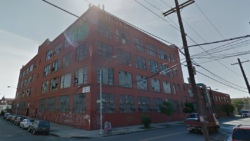
75 Stewart Avenue, Brooklyn. Image credit: CityLand
Tenants sought loft law protection by claiming that two attached structures on one zoning lot were two separate buildings. A two-story building was constructed at 538 Johnson Avenue in the Williamsburg section of Brooklyn in 1916 using timber and wood planking. A four-story building was constructed adjacent at 75 Stewart Avenue in 1919 using concrete columns, beams and slabs. The four-story structure abuts the eastern wall of the two-story structure, and the stairwell in the two-story building was extended to reach all four floors. Both buildings were owned by Goldberger Dolls for 50 years, and were used in the production of dolls. In 1997 Goldberger sold the buildings under a single deed to Brocho V’Hatzlocho Corporation.
Brocho operated a printing company on the first, second and third floors of the four-story building, and parts of the two-story building. In 1998, Brocho leased the second floor of the two-story building and the fourth floor of the four-story building to three different entities, which in turn subdivided the floors into loft-style units. Also, in 2009 Architectural Coating, Inc., a metal treatment and coating facility, renewed a ten-year lease to rent a portion of the ground floor in the two-story building.
In 2012, loft tenants began filing coverage applications with the Loft Board, referring to the two-buildings interchangeably as a single building. In response, Broncho opposed, arguing that the metal coating operation on the ground floor of the two-story structure constituted an incompatible commercial use. Tenants in the four-story building then asked that their four-story building be recognized as an independent building in order to obtain loft law protection.
Administrative Law Judge John B. Spooner ruled in favor of Brocho, finding that the two-story building, and four-story building, constituted a single building under the Loft Law and rejected the tenants’ application for loft law protection. The Loft Law defines a building as a structure bounded by either open area or the lot lines of a zoning lot, and explicitly states that “a building may be a row of structures, and have one or more structures on a single zoning lot.” The finding was further supported by factors promulgated by the Loft Board in determining whether a structure is a single building, including common ownership, same zoning lot, internal passageways, and past use of the structure. ALJ Spooner rejected the argument that the Zoning Resolution definition should control a Loft Board issue.
Matter of Higbee, OATH Index Nos. 222/14, 385/14, 2744/15, 1997/16 (July 26, 2017).

